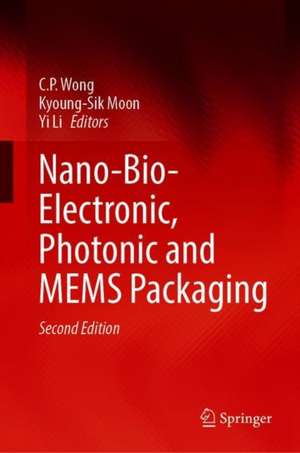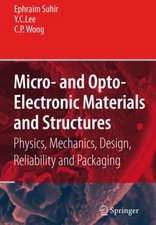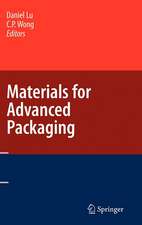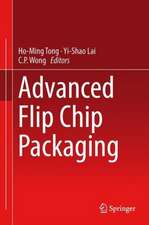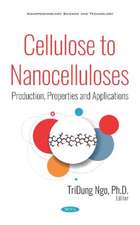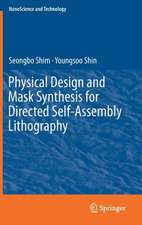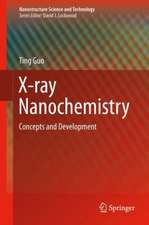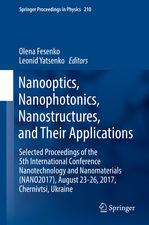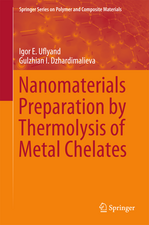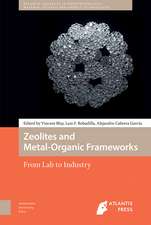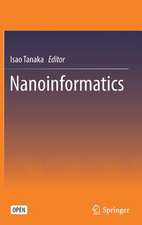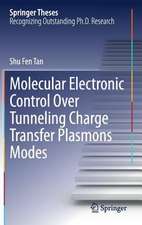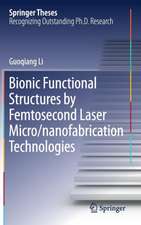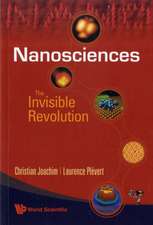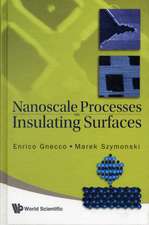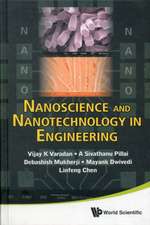Nano-Bio- Electronic, Photonic and MEMS Packaging
Editat de C. P.(Ching-Ping) Wong, Kyoung-sik (Jack) Moon, Yi Lien Limba Engleză Hardback – 18 mar 2021
- Offers a comprehensive overview of nano and bio packaging and their materials based on their chemical and physical sciences and mechanical, electrical and material engineering perspectives;
- Discusses nano materials as power energy sources, computational analyses of nano materials including molecular dynamic (MD) simulations and DFT calculations;
- Analyzes nanotubes, superhydrophobic self-clean Lotus surfaces;
- Covers nano chemistry for bio sensor/bio material device packaging.
Nano- Bio- Electronic, Photonic and MEMS Packaging is the ideal book for all biomedical engineers, industrial electronics packaging engineers, and those engaged in bio nanotechnology applications research.
| Toate formatele și edițiile | Preț | Express |
|---|---|---|
| Paperback (1) | 1139.42 lei 6-8 săpt. | |
| Springer International Publishing – 19 mar 2022 | 1139.42 lei 6-8 săpt. | |
| Hardback (1) | 1582.67 lei 3-5 săpt. | |
| Springer International Publishing – 18 mar 2021 | 1582.67 lei 3-5 săpt. |
Preț: 1582.67 lei
Preț vechi: 1930.08 lei
-18% Nou
Puncte Express: 2374
Preț estimativ în valută:
302.85€ • 323.85$ • 252.51£
302.85€ • 323.85$ • 252.51£
Carte disponibilă
Livrare economică 27 martie-10 aprilie
Preluare comenzi: 021 569.72.76
Specificații
ISBN-13: 9783030499907
ISBN-10: 3030499901
Pagini: 582
Ilustrații: XIII, 582 p. 500 illus. in color.
Dimensiuni: 210 x 279 mm
Greutate: 1.54 kg
Ediția:2nd ed. 2021
Editura: Springer International Publishing
Colecția Springer
Locul publicării:Cham, Switzerland
ISBN-10: 3030499901
Pagini: 582
Ilustrații: XIII, 582 p. 500 illus. in color.
Dimensiuni: 210 x 279 mm
Greutate: 1.54 kg
Ediția:2nd ed. 2021
Editura: Springer International Publishing
Colecția Springer
Locul publicării:Cham, Switzerland
Cuprins
Part1. Electronics (electrical interconnections and thermal management).- Chapter 1.Nanomaterials for Microelectronics, Biomedical, MEMS, and Energy Devices Packaging.- Chapter 2. Nano-conductive Adhesives for Nano-electronics Interconnection.- Chapter 3. Applications of Carbon Nanomaterials as Electrical Interconnects and Thermal Interface Materials.- Chapter 4. Nanomaterials via Nano Spray Combustion Chemical Vapor Condensation, and Their Electronic Applications.- Chapter 5. Nanolead-Free Solder Pastes for Low Processing Temperature Interconnect Applications in Microelectronic Packaging.- Chapter 6. Introduction to Nanoparticle-Based Integrated Passives.- Chapter 7. Thermally Conductive Nanocomposites.- Chapter 8. Physical Properties and Mechanical Behavior of Carbon
Nano-tubes (CNTs) and Carbon Nano-fibers (CNFs) as Thermal Interface Materials (TIMs) for High-Power Integrated Circuit (IC)Packages: Review and Extension.- Chapter 9. On-Chip Thermal Management andHot-Spot Remediation.- Chapter 10. Some Aspects of Microchannel Heat Transfer.- Part II.BioMEMs packaging.- Chapter 11. Nanoprobes for Live-Cell Gene Detection.- Chapter 12. Packaging for Bio-micro-electro-mechanical Systems (BioMEMS) and Microfluidic Chips.- Chapter 13. Packaging of Biomolecular and Chemical Microsensors.- Chapter 14. Nanobiosensing Electronics and Nanochemistry for Biosensor Packaging.- Chapter 15. Biomimetic Lotus Effect Surfaces for Nanopackaging.- Part III. Wearable devices packaging and materials.- Chapter 16. Soft Material-Enabled Packaging for Stretchable and Flexible Hybrid Electronics.- Part IV. Biomedical devices packaging.- Chapter 17. Evolution of Advanced Miniaturization for Active Implantable Medical Devices.- Part V. Optical device packaging.- Chapter 18. An introduction of the phosphor converted white LED packaging and its reliability.- Part VI. Energy harvesting.- Chapter 19. Mechanical Energy Harvesting Using Wurtzite Nanowires.- Chapter 20. 1D Nanowire Electrode Materials for Power Sources of Microelectronics.- Part VII. Energy storage (LIB battery).- Chapter 21. Graphene-based materials with tailored nanostructures for lithium-ion batteries.- Part VIII. Energy storage (supercapacitor).- Chapter 22. Fe-Based Anode Materials for Asymmetric Supercapacitors.- Part XI. Metrology.- Chapter 23. Nanoscale Deformation and Strain Analysis by AFM/DIC Technique.- Part X. Computational.- Chapter 24. Molecular Dynamics Applications in Packaging.- Chapter 25. Nano-Scale and Atomistic-Scale Modeling of Advanced Materials.
Notă biografică
C. P. Wong is the Charles Smithgall Institute Endowed Chair and Regents’ Professor at Georgia Institute of Technology and a member of the National Academy of Engineering of the USA since 2000, and a foreign academician of the Chinese Academy of Engineering since 2013. After his doctoral study at Pennsylvania State University, he was awarded a two-year postdoctoral fellowship with Nobel Laureate Professor Henry Taube at Stanford University. Prior to joining Georgia Tech, he was with AT&T Bell Laboratories for many years and became an AT&T Bell Laboratories Fellow in 1992. His research interests lie in the fields of polymeric materials, electronic packaging and interconnect, interfacial adhesions, energy storage devices, nano-functional material syntheses and characterizations. nano-composites such as well-aligned carbon nanotubes, graphenes, lead-free alloys, flip chip underfill, ultra-high k capacitor composites and novel lotus effect coating materials.
Kyoung-sik (Jack) Moon is Research Faculty with the School of Materials Science and Engineering at George Tech. He received the B.S., M.S. and Ph.D. degrees in materials science and engineering from Korea University, Seoul, Korea, in 1995, 1997 and 1999, respectively. He has published over 135 journal and 140 proceedings papers as author and co-author. His research interests lie in the materials for electrical and thermal interconnections and chemical, physical and electromagnetic protections of IC devices in microelectronics and photonics packaging, and energy storage devices.
Yi Li is Engineering TD manager at Intel Corp. Chandler, AZ, USA. She received the B.S. and M.S. degrees in materials science and engineering from Zhejiang University, Hangzhou, China, in 2000 and 2002, respectively, and the Ph.D. degree in materials science and engineering from the Georgia Institute of Technology, Atlanta, in 2007. She is the author of four book chapters and authored and coauthored 30 technical papers and 40 conference proceedings. Her research interests focus on the materials and process of high-performance lead-free interconnect for electronics packaging, including the application of nano- and bio-materials in advanced polymer composites. Her research interests also include the thermal management of packaging.
Kyoung-sik (Jack) Moon is Research Faculty with the School of Materials Science and Engineering at George Tech. He received the B.S., M.S. and Ph.D. degrees in materials science and engineering from Korea University, Seoul, Korea, in 1995, 1997 and 1999, respectively. He has published over 135 journal and 140 proceedings papers as author and co-author. His research interests lie in the materials for electrical and thermal interconnections and chemical, physical and electromagnetic protections of IC devices in microelectronics and photonics packaging, and energy storage devices.
Yi Li is Engineering TD manager at Intel Corp. Chandler, AZ, USA. She received the B.S. and M.S. degrees in materials science and engineering from Zhejiang University, Hangzhou, China, in 2000 and 2002, respectively, and the Ph.D. degree in materials science and engineering from the Georgia Institute of Technology, Atlanta, in 2007. She is the author of four book chapters and authored and coauthored 30 technical papers and 40 conference proceedings. Her research interests focus on the materials and process of high-performance lead-free interconnect for electronics packaging, including the application of nano- and bio-materials in advanced polymer composites. Her research interests also include the thermal management of packaging.
Textul de pe ultima copertă
This book shows how nanofabrication techniques and nanomaterials can be used to customize packaging for nano devices with applications to electronics, photonics, biological and biomedical research and products. It covers topics such as bio sensing electronics, bio device packaging, MEMS for bio devices and much more, including:
- Offers a comprehensive overview of nano and bio packaging and their materials based on their chemical and physical sciences and mechanical, electrical and material engineering perspectives;
- Discusses nano materials as power energy sources, computational analyses of nano materials including molecular dynamic (MD) simulations and DFT calculations;
- Analyzes nanotubes, superhydrophobic self-clean Lotus surfaces;
- Covers nano chemistry for bio sensor/bio material device packaging.
Nano- Bio- Electronic, Photonic and MEMS Packaging is the ideal book for all biomedical engineers, industrial electronics packaging engineers, and those engaged in bio nanotechnology applications research.
Caracteristici
Offers a comprehensive overview of nano and bio packaging that includes electrically conductive nanomaterials, thermal interfacial materials, nanotubes and superhydrophobic self-clean Lotus surfaces, soft materials for stretchable and flexible electronics and photonics, and more Discusses nano materials as power energy sources and examines their importance on the device level Covers nano chemistry for bio sensor/biomedical device packaging
